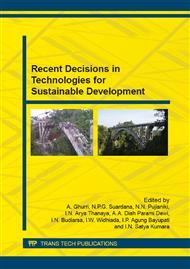p.17
p.24
p.30
p.36
p.41
p.47
p.53
p.59
p.66
Laboratory Tests on Failure of Retaining Walls Caused by Sinusoidal Load
Abstract:
The failure of retaining wall construction can be occurred due to the forces acting on the rear wall exceed the capacity of its stability. Dynamic acceleration parameters can affect the movement pattern of granular soil behind the retaining wall. This research aims to study the movement of grain behind the retaining wall by laboratory testing. The retaining wall model was made in the glass box of a length of 2 meters, width of 0.4 meter and height of 1 meter. This models used gravity types, which was made of concrete and was placed on dry sand with a trapezoid-shaped a height of 20 centimeters, width of peak 2 centimeters and width of below 10 centimeters. The model was examined using dry sand material with grain size that can pass through sieve No. 4 and retained on sieve No.100 of loose sand density (γd = 1.4184 gr/cm3). The model was vibrated using shaking tables with a given variation on sinusoidal loads and was recorded using accellerometer. The displacement of granular soil in a particular point was also monitored during vibration. The results shows that there is different grain movements resulted from different acceleration. The increase in vibration accelerates the grain to fill the empty space between the grains. This causes wider movement area of the grain and expands the landslide areas.
Info:
Periodical:
Pages:
41-46
Citation:
Online since:
July 2015
Keywords:
Price:
Сopyright:
© 2015 Trans Tech Publications Ltd. All Rights Reserved
Share:
Citation:


